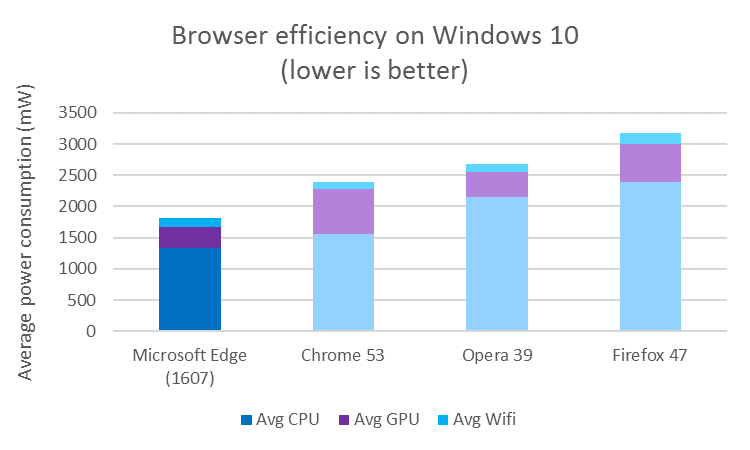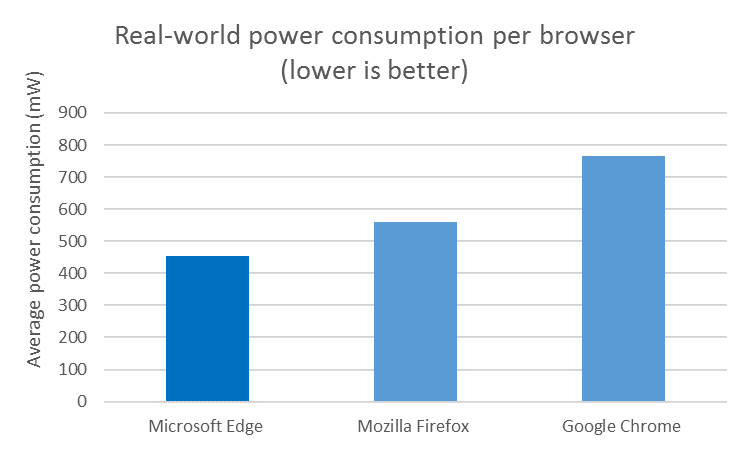Microsoft Edge now gets even more out of your battery
At the risk of giving away the ending, the results may look familiar! With the Windows 10 Anniversary Update, Microsoft Edge is more efficient than ever, and still the best choice for extending your battery life on Windows 10 – up to 24%-43% more efficient than the competition for general purpose browsing, and lasting up to 23%-69% longer when streaming video.
Netflix streaming test conducted on identical Microsoft Surface Books.
See methodology document for details.
Microsoft Edge is even more efficient for browsing the Web
Our improvements to Microsoft Edge, as well as improvements to Windows as a whole, have paid off with 12% better overall rendering efficiency in simulated browsing (compared to Windows 10 version 1511).

Of course, our competitors haven’t been sitting still! We’re thrilled to see the response our first round of tests inspired, including battery life improvements landing in recent releases of other browsers, as well as a spirited debate over methodology and results.
With that in mind, we’d be remiss if we didn’t check in on the progress of each browser we measured. We repeated our lab test on the latest stable releases of Microsoft Edge, Google Chrome, Mozilla Firefox*, and Opera (with Battery Saver on) on identical devices running the Windows 10 Anniversary Update. How did it go?

We’re thrilled to see improvements across the board, but the trend may look familiar! Microsoft Edge remains the most efficient browser on Windows 10, offering 24%-43% more efficiency across a sample of typical activities including video playback, multi-tab productivity, shopping, social media, and more.
Microsoft Edge lets you stream even longer
Our customers are experiencing improved battery life with Microsoft Edge every day, and the easiest way to see it for yourself is to watch it in action! In the video above, we repeated our Netflix streaming test on the Anniversary Update, and Microsoft Edge lasts up to 23%-69% longer than the other browsers we measured – more than 90 minutes longer than Google Chrome.
The Chrome team recently released a similar video, where they focused on comparing the latest version of Chrome to a release from last year to demonstrate some improvements. However, they didn’t include other browsers in this test. Because the format was so similar to our tests, we shot a second video to compare like for like, this time using their methodology: looping the same video from Vimeo, instead of Netflix. In this test, Microsoft Edge lasted even longer – more than 13 hours! – and still beats Chrome by more than an hour. Microsoft Edge even lasted 62% longer – more than five hours! – when compared to Firefox.
Vimeo streaming test conducted on identical Microsoft Surface Books.
See methodology document for details.
Regardless of which test you choose, the conclusion is the same: Microsoft Edge lets you browse and watch longer, so you can get more out of your devices without worrying about finding an outlet.
Realistic and transparent power tests
From the moment we decided to revisit our tests, we were committed to measuring real-world scenarios with a completely transparent methodology. To back up our results, we’re open sourcing our lab test on GitHub and publishing the full methodology for our video tests, so anyone can see the setup and even reproduce the tests independently.
While we’ve open sourced the tests and made some minor updates to maintain compatibility with updates to third party browsers, our approach is very similar to our previous tests. We measured efficiency in a few different ways:
In our lab test, we simulated common real-world activities like searching, watching videos, shopping, and reading e-mail, using multiple tabs with background activity to simulate a natural browsing session and measuring power consumption directly with hardware instrumentation. We’ve open-sourced this full test, and you can see everything you need to reproduce the lab tests for yourself on our GitHub repository here, or review the methodology document here.
Next, we repeated our video rundown test, looping a streaming video on a range of identical devices and recording when each died. You can find the video test methodology documented here (Netflix test) and here (Vimeo test).
Results confirmed by real-world measurements
We’re confident in the quality of our tests, but ultimately nothing beats real-world experiences. To validate our improvements and make sure we’re giving our customers the best experience possible, we monitor aggregated telemetry on power consumption from millions of Windows 10 devices around the world.
Let’s check in on the Anniversary Update numbers and see how each browser fares!

This data is consistent with the lab results above, demonstrating that Microsoft Edge is more efficient in real-world, day-to-day use than the competition.
What improved in the Anniversary Update
The improved efficiency with the Windows 10 Anniversary Update reflects a number of updates across the product, including improved background tab efficiency, more efficient Flash, improvements to the app frame itself, and improved networking. You can learn more about how we designed Microsoft Edge in the Windows 10 Anniversary Update for efficiency in our blog post on the Microsoft Edge Dev Blog, Building a more power efficient browser.
A continued focus on longer battery life
There is more to come! We understand how important battery life is to Windows customers, which is why we’re passionate about making Microsoft Edge the most power efficient browser on Windows 10. We’ll continue to deliver power-saving features and optimizations in the upcoming releases, using fewer CPU cycles and minimizing the impact of background activity when tabs are visible and out of view. All so you can do more and use less.


